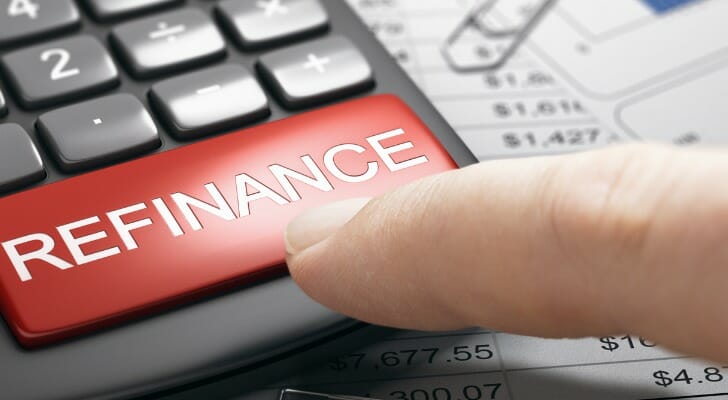If you’re looking for a way to lower your mortgage payments or get your home loan paid off faster, refinancing may be a good option. Refinancing involves swapping your existing mortgage for a new one with more favorable terms. There are a number of advantages to refinancing, but the process isn’t without certain drawbacks – especially when it comes to the fees involved. Depending on your situation, the costs of refinancing could outweigh the benefits, so you need to know what you can expect.
Do you have questions about how refinancing fits into your larger financial plan? Speak with a financial advisor today.
What Does It Mean to Refinance a Mortgage?
Mortgage refinancing is a strategy that helps homeowners meet their goals. This could mean refinancing to a lower interest rate or refinancing to a different mortgage term. Refinancing a home is a major financial decision and one that shouldn’t be made without doing all the research.
When you refinance, your new lender pays off your old mortgage and replaces it with a new mortgage. Most people refinance to reduce their monthly payment, but some refinance from a 30-year to a 15-year mortgage term if they want to knock out their mortgage debt more quickly.
Refinancing is not the same as a second mortgage. A second mortgage gives you money from your home equity. Refinancing gives you an entirely new mortgage, ideally with more favorable terms.
How to Refinance Your Mortgage
Once you decide to refinance your home, there are a few steps you’ll need to take to actually get the ball rolling.
First, you’ll need to know a few key numbers. Your credit score is key, as it will partially determine the rate you are able to get. Second, you’ll need to know your home’s current value, which can be found through research on online real estate sites.
Next, start researching mortgage rates using things like SmartAsset’s mortgage rate tool. Once you’ve found a rate that makes sense to you, you’ll need to gather all of the documentation relevant to your mortgage: bank statements, pay stubs, and anything else your lender requests. Finally, you can lock your rate in with your lender. Make sure to have some cash to pay for things like closing costs, property taxes and other fees.
Adding Up the Costs of Refinancing

Generally, when you buy a home you have to pay certain closing costs to complete the sale. When you refinance, you’re essentially replacing your original mortgage loan with a new one which means you have to pay closing costs again. The closing costs for a refinance cover a wide range of fees and can easily total several thousand dollars. Of course, the risk of refinancing is that you might not recoup your closing costs, particularly if you don’t stay in the home for very long after refinancing.
The first thing you’ll have to pay is the application fee. Typically this fee covers the credit check, certain administrative costs and it may also include the appraisal. Depending on the lender, you could pay as little as $75 or as much as $500 just to apply for a refinance. There are no refunds if your application is denied. If the appraisal isn’t included in the application fee, you can expect to pay a professional appraiser anywhere from $300 to $1,000 for their time.
Assuming your application receives approval, you’ll also have to pay a loan origination fee. This fee covers the lender’s administrative and financing costs and it’s usually one percentage point of your refinance loan amount. If you’re refinancing a $200,000 mortgage, you’re looking at an origination fee of $2,000. You may also have to pay a separate fee to the lender for reviewing the refinancing documents before closing. This can run anywhere from $200 to $400.
Before you start the refinance process, it’s a good idea to find out whether you’ll encounter a prepayment penalty. Certain lenders will charge you for paying off your mortgage loan early even if you’re refinancing. The fee could be several months’ worth of mortgage payments. Some of the other costs you may have to pay include a title search fee, an inspection fee, flood certifications, recording fees and attorneys’ fees. These fees can easily increase the cost of a refinance by several hundred dollars or more.
What Are the Benefits of Refinancing?
The number one reason that many people refinance is to get a lower interest rate on their mortgage. Some even choose to buy points to lower their rate. This essentially means paying an upfront fee in exchange for a lower monthly rate. A lower rate translates to lower payments, which means you’ll pay less for your home overall. Paying less towards your mortgage each month also frees extra cash in your budget that you can put towards your short- and long-term savings goals.
Refinancing also offers an advantage if you want to clear your mortgage debt in less time. If you’ve got a 30-year loan, refinancing to a 15-year mortgage means you’ll own your home free and clear that much sooner. You’ll also be able to build equity in your home faster if you take this route. The only downside is that you’ll have to shell out more money towards your payments each month which could make money tight if you’re not careful.
Taking out a fixed-rate loan also makes sense if you’ve got an adjustable rate mortgage or you want to consolidate a home equity line of credit (HELOC) into your primary mortgage. Adjustable rate loans can save you money in the short-term but they can be dangerous if your payment suddenly shoots up due to a rate change.
The same is true if you’ve got a HELOC that’s approaching the end of its interest-only repayment period. Once you have to start repaying the principal, you could see your payments increase substantially which can put a major strain on your wallet. Refinancing to a fixed-rate loan helps you avoid any nasty surprises in both situations.
Is Refinancing the Right Choice for You?

When you’re trying to decide whether to refinance, the best thing to do is go through the numbers. Figure out how much you’ll save and whether it’s worth the fees you’ll have to pay. If the closing costs are a relatively high, it’ll take you longer to recoup the expenses in savings.
For example, if you’re paying $4,000 in closing costs and you’re saving $200 a month on your mortgage, it’ll take you 20 months to reach the break even point. If you’re planning on moving again in the near future, it may not make sense to refinance since there’s no guarantee you’ll recover the costs. On the other hand, if you are planning on staying put, refinancing could potentially help you save.
Bottom Line
The process of refinancing sounds much more intimidating than it actually is. Furthermore, it could be a really beneficial move if the rate environment is suitable for it. That means doing research ahead of time is of paramount importance.
Homebuying Tips
- A financial advisor can be a big help in navigating the home buying journey. Finding a qualified financial advisor doesn’t have to be hard. SmartAsset’s free tool matches you with up to three financial advisors who serve your area, and you can interview your advisor matches at no cost to decide which one is right for you. If you’re ready to find an advisor who can help you achieve your financial goals, get started now.
- Wondering if refinancing is the right move for you? Try to get an idea of what the overall rate environment looks like. Use SmartAsset’s rate comparison tool as a starting point.
- If you’re still looking for a house, it can be intimidating to find the right home for you. Money may be the most intimidating part of all of it. After all, you don’t want to go too far and end up in a place that’s too expensive. See how much house you can afford with SmartAsset’s home affordability tool.
Photo Credit: © iStock/MartinPrescott, © iStock/Olivier Le Moal, © iStock/fizkes
